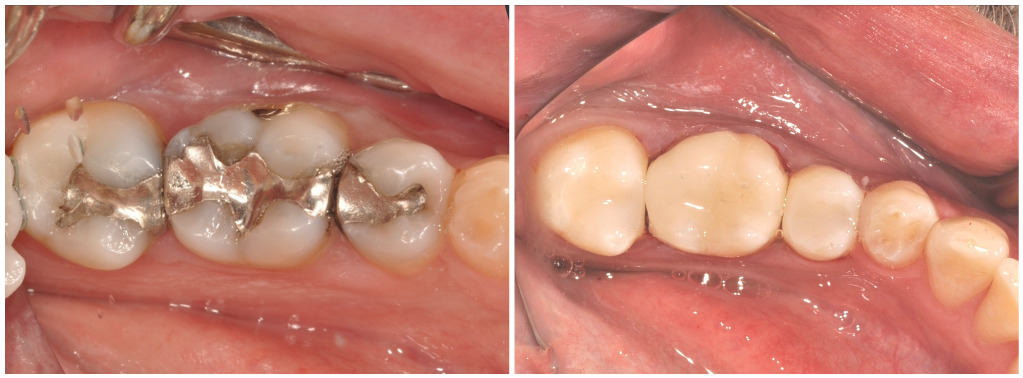This treatment describes the removal of the nerve tissue and blood vessels located inside a tooth. A tooth’s root cannot be left hollow, so the area is filled or sealed up with a caulk-like material. The predictability of a root canal depends on both the quality of the diseased tooth and the technique used to treat it.
Root canals are described as a “therapy” and not a cure. Not all cases are successful even though the dentist did everything correctly. For this reason, difficult teeth are usually best treated by a specialist. We have an excellent relationship with the area’s top specialists to help you get a high quality root canal treatment if the need arises. As was mentioned, not all diseased and damaged teeth are preserved indefinitely with root canal treatment. However, when conditions are favorable, a well done root canal is successful well over 90% of the time.
Here is what an X-Ray of a root canal treated tooth looks like:

A bridge can be used to replace missing teeth when there are enough healthy teeth in the area to connect to. Bridges are permanent like crowns and are not removable. Sometimes they are the best choice to replace a missing tooth when an implant is not feasible.
Here is an example of a bridge done in our office:

Most crowns today are made from a tooth colored porcelain. In our office, the majority of crowns are made while you wait. This means no more temporary crowns or second appointments to have them placed. These crowns are designed and milled with Sirona’s Cerec CAD/CAM technology.
Here is a case done in our office:

There are many ways to replace a few missing teeth. “Partials” can be made out of metal and plastic, or just plastic. Cost can vary depending on the materials used in the construction and the technique used to fit the appliance to the mouth.
For upper teeth, there is a flexible partial that blends into the surrounding gum and looks great. This type of partial is best used when the patient values cosmetics and comfort.
Flexible Partial

The traditional metal-based partial is more expensive than the others. Though it doesn’t look as good as a flexible partial, it is the most durable and long lasting. This type is best used when teeth are missing in the lower jaw or when there are only a few remaining natural teeth.
Metal Base Partial

The least expensive is a “flipper.” This is like an old fashion pink orthodontic retainer with teeth on it (pictured below on left). As an alternative, there is also a clear retainer with teeth that can be used for cosmetic purposes (pictured below on right). These temporary solutions are designed as an inexpensive cosmetic treatment for missing front teeth. They are not intended for chewing.
Temporary Partials

These are made for people that are missing all of their teeth in one or both jaws. We use high quality industry standard acrylic for the teeth and gum construction. Our complete dentures are custom made and fitted over a few appointments. We are not a denture-in-a-day clinic. Instead, if you are looking for an office that takes the time and effort to create a smile that is suited to your liking, you have found the right place.

Full Arch Implants
One of the most common complaints from a denture wearer is that their teeth move around and cause sore spots. Some complain that it is hard to chew because their teeth won’t sit still. This is especially true for lower dentures. Ask your friends or relatives that have full dentures, they are sure to agree.
Implants can be used to attach the dentures to the jaws. In doing so, much of the plastic that covers the top and sides of the denture can be removed. This makes wearing the dentures much more enjoyable. After all, the teeth don’t move anymore, chewing ability improves, food textures return to normal, and sore spots do not develop.
There are many ways to configure how and where the teeth are attached to the patient’s mouth. Most allow the patient to remove the teeth at night and clean them. However, if the patient prefers, the teeth can be made to stay in permanently with removal only possible by the dentist.
As with most things, there are pros and cons to each approach to dentures that are attached with implants. The many options allow patients to find a proposal that suits their budget and needs.
Here are some cases restored in our office:
(Removable by the Patient)

(Not Removable by the Patient)

Implants are an exciting development in dentistry. They can be utilized to replace one tooth or multiple teeth. At Westmount Dental Arts, we have replaced “front teeth”, “back teeth”, and in some cases, “all teeth” for patients in need. When placed and maintained properly, dental implants can last a lifetime.
Single Tooth Implant
There is often some confusion about what a dental implant actually is. It is best to think of the “implant” as a “root” replacement. The implant is basically a hollow titanium “screw” that is placed under the gum tissue. Attached to this “screw” is a part called an “abutment.” You can think of it as a connector. Once this “connector” is placed onto the implant, a “crown” is placed onto this connector. This “crown” is what you chew with and generally think of as a tooth. So there are three parts utilized in replacing a tooth with an implant. They are the implant, abutment, and crown.


At Westmount Dental Arts, we use modern materials. All of our fillings are done with a bonded tooth colored composite resin. The mercury containing black or silver fillings of the past are not used in our office.
Here is an example of the difference composite fillings can make:
